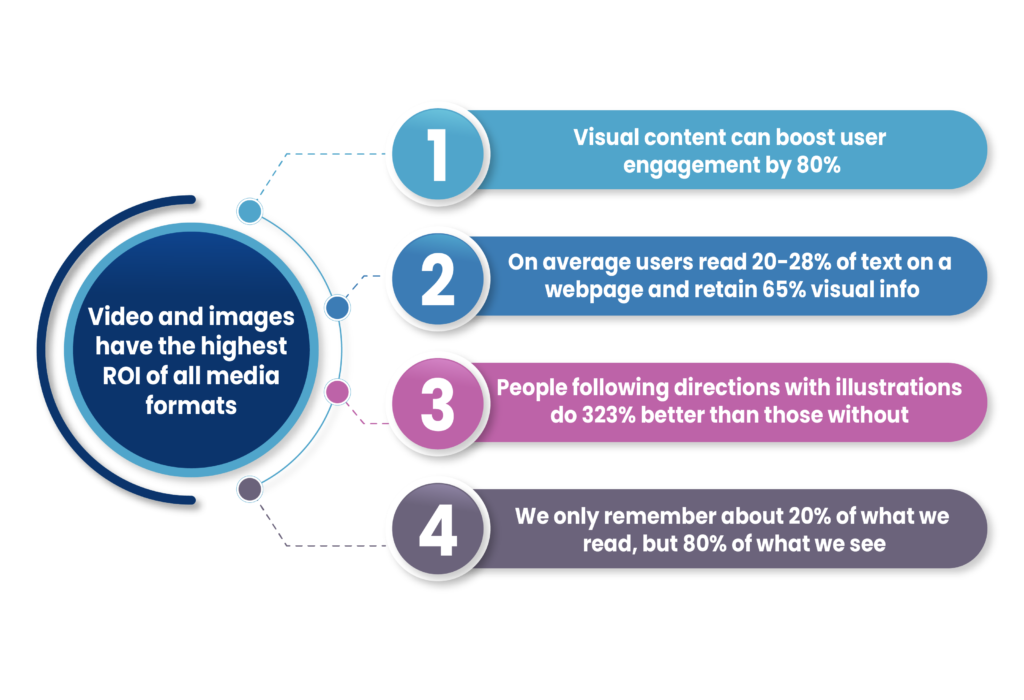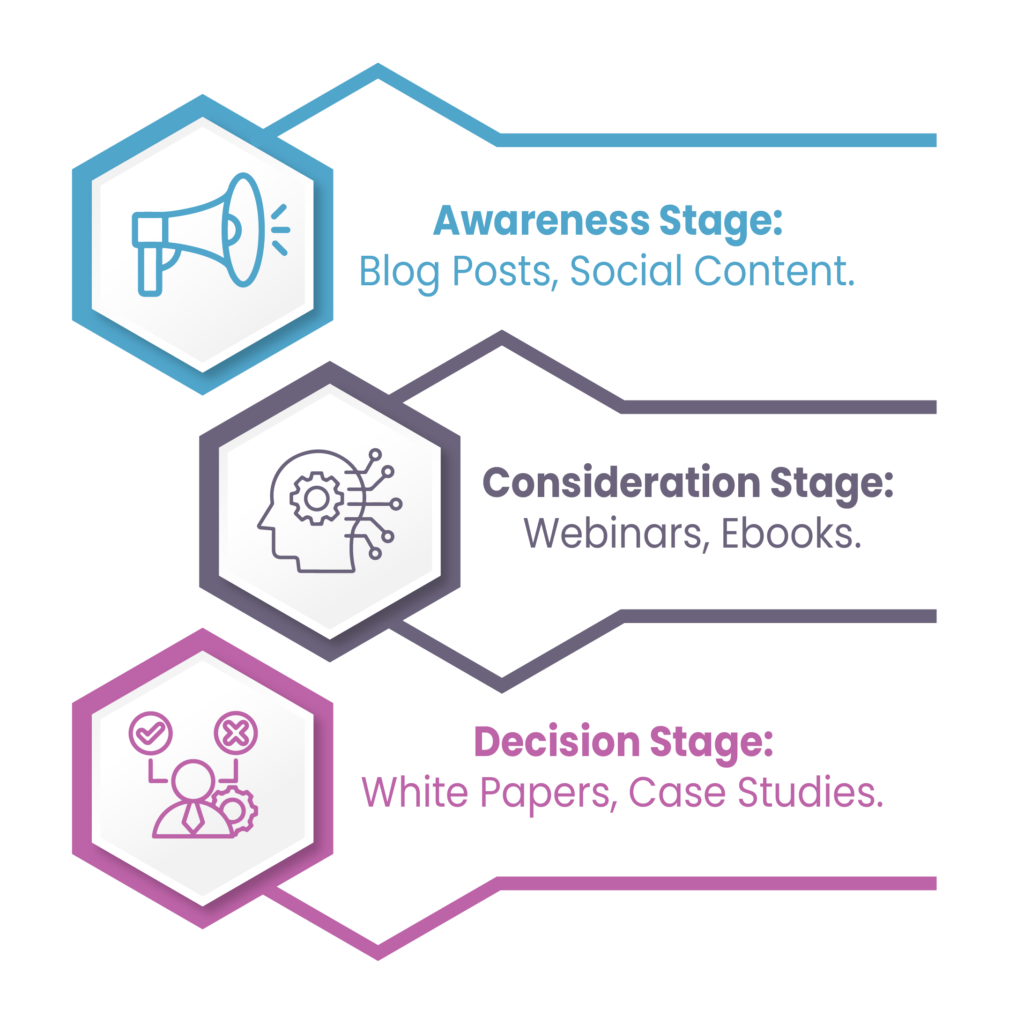In cybersecurity, where things can change in the blink of an eye, setting your company up as a trusted authority is essential. Thought leadership enables you to stand out by offering valuable insights into technological advancements, and emerging threats. It’s not just about staying relevant—it’s about positioning your brand as a problem-solver and a go-to resource for businesses navigating this constantly shifting market.
Choosing the right content format is key to maximizing the impact of your thought leadership. Each format serves a distinct purpose, catering to different audience segments and stages of the buyer’s journey. By aligning your content strategy with your goals and target audience, you can ensure your message resonates and delivers meaningful engagement.
Thought leadership matters in cybersecurity
Cybersecurity is more than just safeguarding data, it’s about fostering trust, driving informed conversations, and influencing decisions. Thought leadership helps companies build credibility and differentiate themselves. It positions your brand as an industry leader, offering insights that educate your audience and provide actionable solutions to their biggest challenges.
But impactful thought leadership isn’t about being the loudest voice in the room —it’s about delivering smarter, more targeted insights. By consistently creating content that builds trust and showcases your expertise, you can attract new prospects, strengthen existing relationships, and foster community engagement.
The formats
Choosing the right content format is crucial for engaging your audience and achieving your business goals. Each format serves a unique purpose and caters to different audience preferences and stages of the buyer’s journey. In this blog we will discuss some of the most impactful formats for cybersecurity thought leadership.
1. White papers
White papers are the cornerstone of in-depth, authoritative content. These documents allow you to tackle complex industry challenges, explore emerging trends, or provide a detailed analysis of your solutions. Designed for decision-makers, white papers help establish your credibility by demonstrating a deep understanding of the topics that matter most to your audience.
White papers are essential for establishing your company as a trusted authority in the cybersecurity space. In a competitive industry, where decision-makers seek reliable partners, these in-depth, data-driven documents can provide the clarity and confidence needed to move forward.
White papers excel in situations that demand a deep dive into complex challenges, such as navigating new regulatory requirements or implementing advanced cybersecurity frameworks. They’re particularly effective when introducing innovative technologies or approaches to a technical audience that value detailed, well-researched insight. By offering clear, actionable guidance, white papers not only influence long sales cycles but also position your brand as a knowledgeable and credible leader.
3. Webinars
Webinars provide a highly engaging, interactive experience that allows you to connect with your audience in real time. They’re perfect for discussing timely issues, demonstrating product capabilities, or bringing together industry experts for thought-provoking discussions. A major benefit of webinars is their flexibility—they can address a broad audience or dive deep into niche topics.
Webinars are a powerful tool for fostering real-time engagement, allowing your audience to interact directly with your experts. They’re ideal for showcasing your thought leadership on critical topics like zero-day vulnerabilities or the role of AI in cybersecurity.
These sessions create a unique opportunity to address questions, clarify complex issues, and build trust with potential clients. Webinars are particularly effective during the mid-to-late stages of the buyer’s journey, when prospects are seeking deeper insights and technical validation.
Their value doesn’t end when the session wraps—recorded webinars can be repurposed into on-demand content, blog posts, or even infographics, extending their impact and reach. Linkedin
3. Reports
Reports leverage proprietary data and research to deliver critical insights into industry trends. Whether it’s a threat overview or a deep dive into organizational cybersecurity practices, reports help position your brand as a data-driven leader.
Reports are a cornerstone of establishing authority and thought leadership, especially when backed by original research. They provide actionable benchmarks that help your audience evaluate their own performance and make data-driven decisions.
Ideal for engaging analysts, media, and C-level executives, reports deliver high-value insights that resonate with key stakeholders. Whether published annually or quarterly, they offer a reliable resource for strategic planning, helping your audience stay informed about industry trends and shifts.
4. Case Studies and Testimonials
Nothing builds credibility quite like real-world proof. Case studies provide detailed examples of how your products or services have solved specific challenges, offering tangible evidence of your value. Testimonials, on the other hand, highlight customer satisfaction in their own words, creating a powerful narrative of trust and reliability. These formats are particularly impactful during the decision-making stage, helping potential clients validate their choice by seeing your solutions in action. Additionally, they can be repurposed across your website, social media, and sales materials, ensuring their value is maximized throughout your marketing strategy.
5. Blog posts
Blogs are a versatile and accessible format for delivering timely content. They’re great for breaking down complex concepts, providing actionable advice, and keeping your audience updated on industry developments. Blogs help improve SEO, driving organic traffic to your website while reinforcing your expertise.
Blog posts are an excellent way to engage a broad audience, regardless of their technical expertise. They provide quick, digestible insights that complement longer-form content like white papers and reports. Ideal for early-stage engagement, blogs help address general cybersecurity questions and respond swiftly to emerging threats. Beyond attracting new readers, regular blog posts play a vital role in nurturing prospects by consistently delivering fresh, valuable content that keeps your audience informed and engaged.Beyond Trust
6. Ebooks
Ebooks offer a comprehensive approach to exploring topics in depth. They blend visual elements with rich content, making them more engaging than traditional white papers. Ebooks are ideal for guiding readers through complex processes or offering step-by-step strategies.
Ebooks are a powerful tool for lead generation, often gated to capture valuable contact information. They excel at educating prospects on broader, strategic topics such as implementing Zero Trust frameworks or developing robust incident response plans.
Designed as in-depth resources, Ebooks provide readers with valuable insights they can revisit as needed. They’re particularly effective in the middle of the funnel, guiding prospects as they evaluate solutions and deepening their understanding of your expertise in solving complex challenges.
7. Videos and podcasts
Videos and podcasts bring your thought leadership to life through dynamic, engaging formats. They’re perfect for connecting with audiences who prefer consuming content on the go or through visual and auditory experiences.
Videos and podcasts are excellent tools for building a personal connection with your audience. Videos bring your brand’s personality to life, using visual storytelling to simplify complex topics and capture attention quickly. They’re particularly effective as top-of-funnel content, such as explainer videos or short, engaging clips for social media.
Podcasts, on the other hand, offer a more conversational approach, ideal for fostering long-term engagement. Through expert interviews or in-depth explorations of niche topics, podcasts provide a platform for sharing thought leadership in a format that’s accessible on the go. Both videos and podcasts are highly versatile, with content that can be repurposed into shorter clips, social media posts, or supporting materials for other formats.
By strategically leveraging these formats, cybersecurity companies can engage their audience at every stage of the buyer’s journey. The key is to align each format with your business objectives and audience preferences, creating a content strategy that delivers real results.
The global popularity of podcasts has surged in recent years, with the number of listeners projected to surpass half a billion by 2024. This growth is mirrored in the United States, where podcast revenues have seen a steady rise, highlighting the format’s expanding influence and profitability.

8. Emails and Newsletters
Emails and newsletters are powerful tools for nurturing relationships and maintaining engagement with your audience. Beyond promoting new content, they serve as a direct line of communication, delivering valuable insights right to your audience’s inbox. With an impressive ROI of $36 for every $1 spent, email marketing is one of the most cost-effective ways to keep your brand top-of-mind. Newsletters are particularly effective at all stages of the buyer’s journey, offering tailored content to match your audience’s evolving needs. Whether you’re sharing curated insights, exclusive content, or updates on industry trends, emails are a versatile format that drives traffic and builds loyalty over time.
Choosing the right content format for your goals
The success of your thought leadership strategy hinges on selecting the right content format to align with your business objectives and audience needs. Different formats serve different purposes, and understanding how to leverage them strategically can make all the difference.
For lead generation, formats like white papers, Ebooks, and webinars are invaluable. These resources offer in-depth insights and solutions, often gated behind a form, allowing you to capture valuable lead information while providing high-value content.
When your goal is to boost brand awareness, blog posts, videos, and podcasts shine. These formats help you reach a broader audience, sparking initial interest and building familiarity with your brand. Their accessibility makes them ideal for engaging prospects who are just beginning to explore cybersecurity solutions.
To establish authority, reports and white papers come into play. These formats position your company as a thought leader by delivering data-driven insights or detailed analyses of industry trends. They show your audience that you not only understand the challenges they face but also have the expertise to guide them through complex decisions.
Equally important is considering where your audience is in the buyer’s journey. Early-stage prospects may benefit most from blog posts or social media content that introduces key concepts. Those in the consideration phase might prefer webinars or Ebooks that dive deeper into specific challenges. Finally, decision-makers evaluating your solutions will appreciate detailed case studies or white papers that validate your expertise and offer clear, actionable recommendations.
By aligning your content strategy with both your goals and your audience’s needs, you can ensure each piece of content serves a clear purpose and drives meaningful engagement.

Best practices for effective thought leadership content
Effective thought leadership content focuses on delivering value. It should address your audience’s specific challenges, offer actionable insights, and be presented in an engaging format. Avoid self-promotion—thought leadership is about offering knowledge and sparking ideas.
Consistency is key. Regularly publishing content, such as annual reports or recurring webinars, helps establish your brand as a reliable source of expertise. Additionally, ensure your content reaches your audience where they are—whether that’s on social media, at industry events, or through trusted publications.
Thought leadership in cybersecurity is about more than just sharing knowledge—it’s about building trust, fostering connections, and driving meaningful engagement. By strategically leveraging a mix of content formats like white papers, webinars, reports, blogs, Ebooks, videos, and podcasts, you can meet your audience where they are and guide them through every stage of the buyer’s journey.
The key to success is aligning your content with your business goals and audience needs. Whether you’re aiming to generate leads, boost brand awareness, or establish your authority, each format offers unique advantages that can help you achieve your objectives. As the cybersecurity landscape evolves, so too should your content strategy. By staying flexible and adapting to changing audience preferences, you can ensure your brand remains a trusted voice in the industry.
When you’re ready to elevate your thought leadership strategy and take advantage of multiple forms of content, reach out to Revonish to learn how we can help you craft impactful content that drives results.
